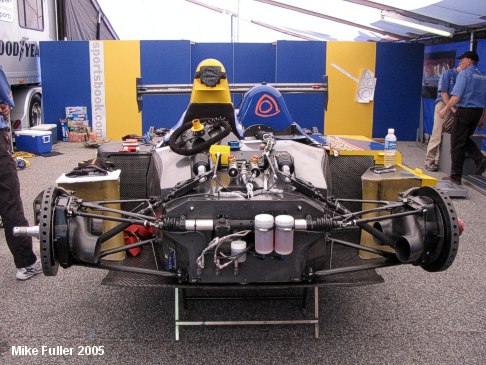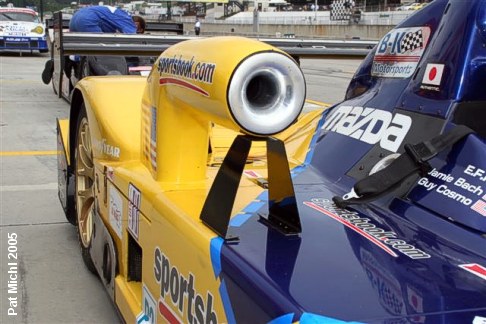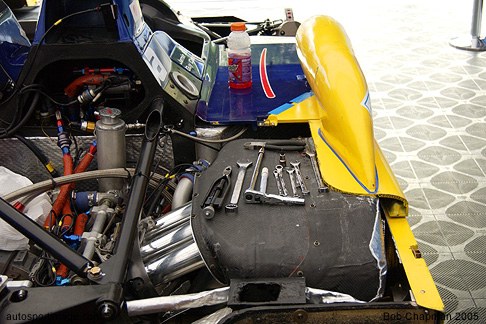 The
Mazda R20B 3-rotor installation in the Courage C65 chassis. The R20B
is longer than the Judd and AER engines and requires a slightly different
mating unit for the bellhousing.
The
Mazda R20B 3-rotor installation in the Courage C65 chassis. The R20B
is longer than the Judd and AER engines and requires a slightly different
mating unit for the bellhousing. The
beer keg is back! The peripheral-port induction R20B isn't much bigger
than a beer keg and almost seems hidden in the engine bay.
The
beer keg is back! The peripheral-port induction R20B isn't much bigger
than a beer keg and almost seems hidden in the engine bay.
Much has been made about this power plant but upon further investigation it is little different from the Mazda 3-rotor of years past. The R20B is Cosmo-based and while it may be accurate to say it is of the Renisis family, it is more of a reverse relationship with the Cosmo engine begetting the current Renisis and not the other way around. Though John Doonan does indicate that this R20B benefits from the Renisis in the area of the rotor design at very least, thus making the R20B Cosmo-based and Renisis influenced.
No matter, it is clear that the ACO mandated 49.1 mm restrictor is a burden and the 3-rotor is not developing much beyond 400 horsepower. Due to the nature of aspiration in a rotary engine, inlet restrictors have a larger impact on rotaries than on comparable (power out put and engine capacity) piston engines. It is our opinion that the Mazda needs to be allowed to run unrestricted. ACO, do you hear us?
7.30.05
Apparently they
did...well, hear someone. Of course that someone was Dennis Spencer
as his group took over engine development duties starting post Sears Point.
Subsequently the ACO and IMSA came to a new agreement with Mazda about
engine inlet restrictor diameters and allowed them to bump the size up
to 53.5 mm.
 In
September a new engine was introduced, the Renesis-20B 3-rotor.
In
September a new engine was introduced, the Renesis-20B 3-rotor. B-K
Motorsports' C65 appears similar to other C65s in the series with the exception
of the modifications necessary to fit the Mazda engine. Like most
contemporary prototypes, the Courage C65's radiators receive cooling air
from intakes in the sidepods as well as exhaust airflow from the front
nose diffuser. Cooling is always an issue with rotary engines because
the oil is used to cool the engine to a much higher percentage than in
comparable piston engines.
B-K
Motorsports' C65 appears similar to other C65s in the series with the exception
of the modifications necessary to fit the Mazda engine. Like most
contemporary prototypes, the Courage C65's radiators receive cooling air
from intakes in the sidepods as well as exhaust airflow from the front
nose diffuser. Cooling is always an issue with rotary engines because
the oil is used to cool the engine to a much higher percentage than in
comparable piston engines. Real
world trials have shown cooling to be an issue. One solution has been
to install louvers into the rear engine deck in order to draw the heat
out of the engine compartment.
Real
world trials have shown cooling to be an issue. One solution has been
to install louvers into the rear engine deck in order to draw the heat
out of the engine compartment. With
the 3-rotor's induction being on the right-hand side of the engine (and
hence the chassis), the engine intake was designed into the driver's primary
roll over structure in order to avoid an overly complicated induction system
fed via the passenger's secondary roll over structure.
With
the 3-rotor's induction being on the right-hand side of the engine (and
hence the chassis), the engine intake was designed into the driver's primary
roll over structure in order to avoid an overly complicated induction system
fed via the passenger's secondary roll over structure. Developments
at Road America saw the introduction of a revised engine intake.
The roll over structure mounted engine intake was blanked off and an intake
periscope mounted.
Developments
at Road America saw the introduction of a revised engine intake.
The roll over structure mounted engine intake was blanked off and an intake
periscope mounted.  The
engine exhaust exit has moved to the side of the car. Previously
it was routed straight out the back.
The
engine exhaust exit has moved to the side of the car. Previously
it was routed straight out the back. The
bracket performs a rules compliance function:
The
bracket performs a rules compliance function:
3.4.5 - Air intakes :
c/ They must not protrude more than
150 mm (200 mm for
the engine air intakes) over the surface
of the bodywork
11.17.05
Well that's what
we thought before, but a little bit of investigation and it turns out the
bracket isn't needed for rule compliance (as the intake isn't anywhere
near 200 mm above the surface ofthe bodywork). Instead it is performing
a funtional aspect by keeping the leading edge of the intake level, helping
to prop it up.
 This
became more important when the inlet height went up exponentially (but
still not above 200 mm) at the 2005 Petit Le Mans:
This
became more important when the inlet height went up exponentially (but
still not above 200 mm) at the 2005 Petit Le Mans: The
periscope engine inlet allows for straight intake runners to the airbox
as opposed to bent to near vertical with the intake installation above
the driver's head.
The
periscope engine inlet allows for straight intake runners to the airbox
as opposed to bent to near vertical with the intake installation above
the driver's head.